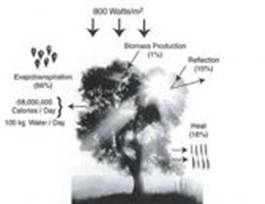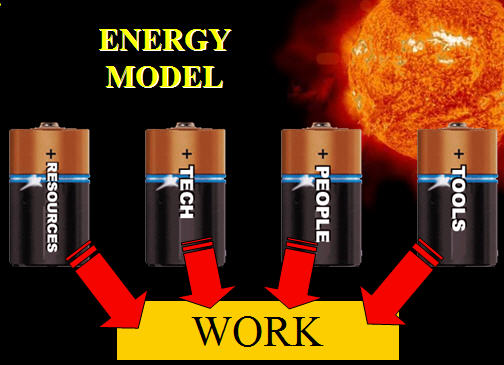All work is driven by solar energy
All activity on earth, including economic activity, is driven by the flow of energy from the sun, “that orbed continent, the fire that severs day from night” (8) . The Second Law of thermodynamics states that heat flows from warm to cold bodies. The difference between the 5800 K surface temperature of the sun, and the temperature of the earth, at 280 K, causes energy to flow from the sun to the earth in the form of radiation, producing work and heat on earth.
Figure 4
Sun-Earth Flux
(Schneider & Sagan, 2005, p. 164)

The sun is a giant thermonuclear reactor that has been turning 5 million tons of hydrogen into helium each second for 5 billion years. Its temperatures vary from 15 million K at its core, to as low as 4000 K in sunspots. The rate of energy delivered to earth by the sun to the earth, 1.36 kilowatts (KW) per square meter, has long been referred to as the solar constant (9) , although recent measurements show it varies by as much as .2%, which equals four times all human energy consumed on earth today
In all, only one billionth of total solar energy falls on the earth. But even this tiny fraction amounts to 5 million horsepower per square mile.
About two-thirds of the radiation that hits the earth’s atmosphere hits the surface, with the remaining one-third absorbed by clouds as heat or reflected back into space.
Only about 1% of captured energy, itself only a small percentage of the energy that hits the earth’s surface, is converted into stored energy in organic molecules through photosynthesis. The energy stored in this way each year is about 1018 kilojoules, which is about 30 times the global consumption of energy today. (Atkins, p. 210)
Figure 5
Storing Solar Energy
(Schneider & Sagan, 2005, p. 222)

Through this seemingly wasteful collection process, stored sunlight makes the earth inhabitable. Sunlight trapped by photosynthesis produces the carbohydrates that feed the plants themselves (plants are autotrophes that produce their own food), which in turn provide the food for heterotrophes, species that do not produce their own food, made up of plant-eaters and animal-eaters, including humans.
Economic activity is the directed transformation and distribution of solar energy to satisfy the needs of man. For most of history, people eked out a bare subsistence living as hunter/gatherers by harvesting current and recently stored solar energy in the form of living plants and animals. We can think of stored solar energy as having a solar vintage, similar to the vintage marked on a bottle of wine that marks the year during which the solar energy captured in its organic molecules reached the surface of the earth. The hunter-gatherers harvested only very young solar vintages; for them the oldest vintage available was the wood they used for fuel, stored only decades before their time.
Modern man enjoys a dramatically higher living standard than the hunter-gatherer because we have recently learned to augment current solar energy by reaching deep into the wine cellar of vintage sunlight to mine stored energy from the distant past.
Wood, has been man’s primary fuel source for all of recorded history. Wood was only surpassed by coal in the closing decades of the nineteenth century, as shown in figure 6, below. Wood energy has a solar vintage measured in decades. In contrast, the sunlight stored in the form of coal reached the earth 350 million years ago during the Carboniferous Period of the Later Paleozoic Era when vast forests flourished in river deltas (Maiklen, 1998, p. 269). Coal was succeeded first by oil, then by gas, after 1950. Together, fossil fuels provide about 85% of the energy we use today.
Figure 6
Stored Energy Consumption
Energy Consumption by Source 1635-2005
(Energy Information Administration, 2006, p. 2)

But this is too narrow a definition of energy to account for today’s levels of economic activity. Traditional fossil fuels and other natural resources are only one form of stored energy; their consumption accounts for only a small percentage of GDP in most nations. The bulk of energy used to produce work is the energy stored as human capital (stored food energy, knowledge, and experience), as technology (stored work and knowledge), and as tools (technology and knowledge stored as physical capital goods), depicted in Figure 7. All are mechanisms for transferring energy from one period to a later time when it can be used to produce work by making people’s efforts more productive.
Figure 7
Thermal Energy Storage and Use

In this framework, then, wealth represents command over stored energy. Stored energy is used to produce work. Work is valued in markets by setting prices which reflect relative scarcities. National income represents gross national work, the price-weighted sum of all work produced.
>>>>NEXT PAGE>>>>
---------------------
(8) Shakespeare, Twelfth Night.
(9) The largest drop yet measured, .23%, occurred in July, 1981 during a period of intense sunspot activity partially blocking radiation. Friedman ( ), p. 87.
|

